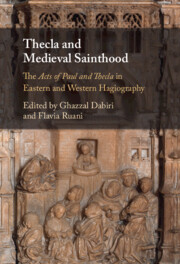Book contents
- Thecla and Medieval Sainthood
- Thecla and Medieval Sainthood
- Copyright page
- Contents
- Contributors
- Acknowledgments
- Abbreviations
- Introduction
- Part I An Act to Follow
- Part II An Act to Surpass
- Chapter 7 Thecla, the First Cross-Dresser?
- Chapter 8 From Diotima to Thecla and Beyond
- Chapter 9 Reception and Rejection
- Chapter 10 A Medieval Sufi Thecla?
- Afterword
- Appendix Summaries of Texts
- Index
- References
Chapter 9 - Reception and Rejection
Thecla and the Acts of Paul and Thecla in the Passion of Eugenia and Other Latin Texts
from Part II - An Act to Surpass
Published online by Cambridge University Press: 06 May 2022
- Thecla and Medieval Sainthood
- Thecla and Medieval Sainthood
- Copyright page
- Contents
- Contributors
- Acknowledgments
- Abbreviations
- Introduction
- Part I An Act to Follow
- Part II An Act to Surpass
- Chapter 7 Thecla, the First Cross-Dresser?
- Chapter 8 From Diotima to Thecla and Beyond
- Chapter 9 Reception and Rejection
- Chapter 10 A Medieval Sufi Thecla?
- Afterword
- Appendix Summaries of Texts
- Index
- References
Summary
In this chapter, I compare the characterization of Thecla in the Latin translation of the Acts of Paul and Thecla (henceforth APT) and of Eugenia in two Latin versions of the Passion of Eugenia (BHL 2667 and 2666). As scholars have already noted, the two Passions of Eugenia differ remarkably: the references to the APT in the oldest version (BHL 2667, second half of the fifth century) are removed in the later rewriting (BHL 2666, sixth or seventh century). Based on earlier scholarship, I contextualize this rewriting as a signal of the wider tendency to use Thecla as a model of virtue, while the APT is rejected for its problematic canonicity; I do so by delving deeper into the wider Latin literature of the late antique and medieval periods. I then demonstrate the ways in which both Passions of Eugenia engage with the figure of Thecla as a model to imitate even as Eugenia surpasses her in terms of rhetoric.
Keywords
- Type
- Chapter
- Information
- Thecla and Medieval Sainthood<I>The Acts of Paul and Thecla</I> in Eastern and Western Hagiography, pp. 256 - 281Publisher: Cambridge University PressPrint publication year: 2022



